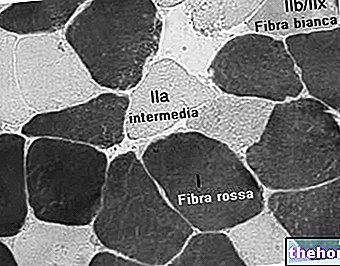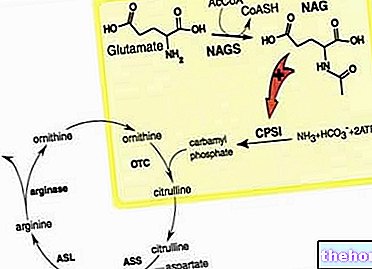The microscope observation of the bone structure allows us to recognize:
- a fibrous or non-lamellar bone tissue
- and a lamellar type bone tissue.
Fibrous or intertwined bone tissue is immature bone and is normally found in the embryo, in newborns, in the metaphyseal site (see below) and during fracture healing. Once deposited, the fibrous tissue is readily reabsorbed and replaced with lamellar type bone tissue.
Under the microscope, the fibrous bone tissue appears as a series of fibers intertwined in the three dimensions of space in an almost random manner. The meshes of this "three-dimensional spider web" are made up of large collagen fibers of considerable thickness (5-10 μm in diameter).
Non-lamellar bone is, on the whole, more elastic and less consistent than lamellar bone, due to the lower quantity of minerals and the lack of a preferential orientation of the collagen fibers.
The lamellar bone tissue forms the mature bone that derives from the remodeling of the fibrous or pre-existing bone tissue. Compared to the previous one, it is a more organized tissue, with an ordered and parallel orientation of the collagen fibers, which are arranged in superimposed layers, called bone lamellae.
Between one lamella and the other, small spaces communicating with each other: the gaps house the cells which, by means of a system of canaliculi, come into contact with the areas of the bone from which they can receive nutritional materials.
Of the two types of tissue, the lamellar is the most widespread and constitutes almost all of the compact bone and a large part of the cancellous bone.
The two types of bone tissue (lamellar and non-lamellar) are distinguished by the arrangement of collagen fibers, ordered in the first type and not ordered in the second.
In adults, all bone tissue is lamellar; we find the non-lamellar type during ossification or during fracture repair.

The lamellar bone tissue can in turn be subdivided into spongy bone and compact bone. The basic composition is the same but their three-dimensional arrangement is different. This diversification makes it possible to optimize the weight and bulk of the bones according to the different stresses they are subjected to.
SPONGY OR TRABECULAR BONE
Presence of trabeculae
The spongy bone is found mainly in the innermost part of the bones, at the level of the short bones, the flat bones and the epiphyses of the long bones.

The trabeculae, variously oriented and intersected with each other, delimit cavities, called medullary cavities, which contain red (hematopoietic) and yellow (fat) marrow.
The spongy tissue gives the bone lightness, thanks to its honeycomb structure, e

This type of bone is most abundant in the spine, ribs, jaw and wrist. It constitutes only 20% of the skeletal mass, but represents the most active metabolic component.
COMPACT BONE OR CORTICAL BONE
Presence of osteons

The compact bone forms the external (more superficial) portion of the short bones, the flat bones and the long bones; it also constitutes the diaphysis of the latter. It is a hard, solid, compact bone, precisely because it has no cavity macrospically evident; small channels are reserved for blood vessels, cells and their processes, necessary to keep it alive.
It constitutes 80% of the skeletal mass. It has a lamellae structure organized in osteons.
OSTEONS are the structural units of compact bone.
Inside, the bone cells (osteocytes) are distributed in biconvex lens-shaped cavities called bone lacunae. The most evident characteristic of the osteone is given by the presence of concentric columns of lamellae (from 4 to 20) that delimit a central canal. Inside this canal, called Havers canal, run nerves and vessels, both blood and lymphatic.
Taken together, lamellae and canal form the haversian system (synonymous with osteone). The various systems communicate with each other (anastomosis), with the medullary cavity and with the free surface of the bone through the channels arranged transversely and obliquely, called Volkmann canals.

In the periosteum we recognize two types of canals:
- Longitudinal (Havers) in which the blood capillary flows.
- Transversal (of Volkmann): they come from the periosteum and the endosteum and flow into the longitudinal ones.
The compact bone confers rigidity, hardness and resistance to mechanical stress.
Most of the compact bone is located in the long bones of the lower and upper limbs.
Other articles on "Spongy bone, compact bone, bone lamellae"
- osteoblasts osteoclasts
- bone
- bones of the human body
- bone tissue
- periosteum endosteum
- bone marrow
- bone remodeling
- bone mass
- height growth
- joints
- Joints: anatomy structure





.jpg)



.jpg)


















